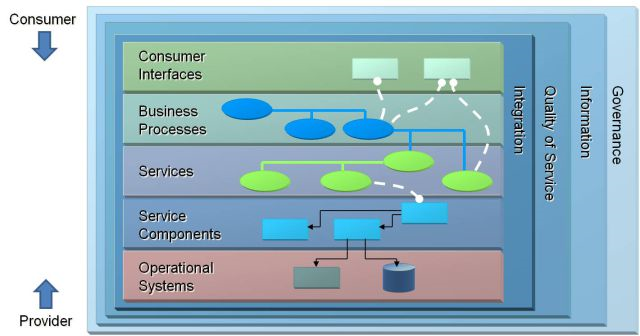A reference architecture is an architectural design pattern that indicates how an abstract set of entities and relationships realizes a predetermined set of requirements, fundamental concepts, and relationships (that is, reference model) in the domain of interest.
The purpose of reference architecture is to give a realization, which is a high-level solution artifact, and to architects, a standard model from which to architect specific solutions for their respective business domain.
According to TOGAF, and in general, we have the following reference architecture continuum from abstract to concrete by influencing and refining further. For each of these categories of architecture, we have a reference architecture:

The diagram means that an SOA reference architecture is categorized as a common systems architecture. It's a generalized reference architecture for SOA, independent of any specific industry and implementation.
The following diagram shows the standard and widely adopted SOA reference architecture as provided by The Open Group (TOG). This reference architecture is focused on solution and application architecture as per the The Open Group Architecture Framework (TOGAF). Generally, all SOA implementations eventually satisfy the elements in this model:

We will now see a simple description of these high-level layers, as mentioned in the preceding SOA reference architecture:
- Operational Systems layer: This contains the operational system components of an enterprise. It primarily includes the infrastructure to support SOA implementation.
- Service Components layer: This includes the software components, which provide implementation for the service.
- Services layer: This includes services with description, contracts, policies, and containers with service components.
- Business Processes layer: It's a collection of the business processes of an enterprise.
- Consumer Interfaces layer: This includes the software components, which enable users to interact and use the services.
- Integration layer: This is probably the most critical layer for an SOA platform. It provides the integration building blocks, including messaging, message transformation, message hub, event processing, service composition, and service registry discovery discovery.
- Quality of Service layer: This layer basically monitors, reports (and manages) the quality of service of the SOA implementation, including its errors, performance, reliability, availability, and security.
- Information layer: This logically includes data, meta-data, analysis, interpretation, and transformation of data.
- Governance layer: This layer contains the governance rules and regulations, and their application on the services and operations.
